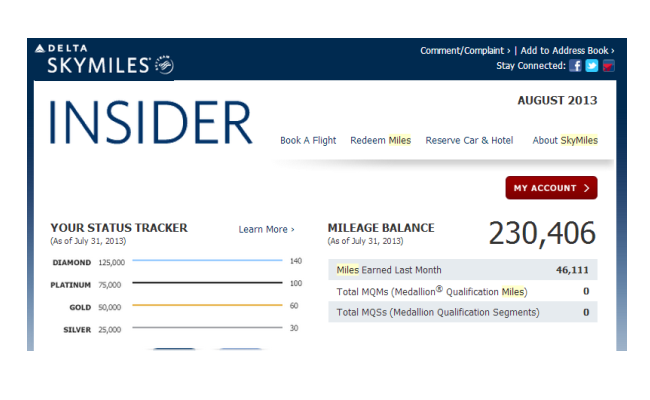Milenomics is a system. It is constantly changing, evolving. Feedback from Milenomics users is always great, and helps me to fine tune things. I want to take a moment to thank you for the continued support. This is my first attempt at a blog, so I’ve been a bit overwhelmed by the response.
Today we learn a new term; maximum mileage. The idea behind the maximum mileage is to give you something to strive for, a goal in each program you hold miles in. Having a goal gives you a set number to reach for and try to attain. It gives you a goal-line to cross over, and makes those late night trips to the grocery store for those gift cards easier to swallow, those miles are getting you somewhere.
Holding more miles than your maximum is not usually a good idea. In fact I’m struggling right now–with not enough time off to draw down my mileage balances, and large balances in AA, UA, US, and DL. I’ve got “too many” miles (yes, that is possible). Continuing to earn in these programs mean I’m holding miles I may not use for years to come. I’m tying up money since miles are not free.
Maximum Mileage is most important for the programs you’ll use for international travel.
Simply put your maximum mileage is:
- Miles per person for next international redemption x Number of passengers.
For examlpe, if you’re looking to use AA miles to travel to Europe, and you fly by yourself, in first class, your Maximum Mileage in AA would be 125,000–one round trip first class seat from US-EU. If you had a wife and 2 kids, and you fly coach your Maximum Mileage would be 60,000 x 4 = 240,000 miles (4x60k r/t coach).
I’ll be booking my South Africa Tickets soon, and in doing so I’ll draw my Delta balance down to about 95,000 miles. I’ll be moving that back up as soon as possible, especially because Delta is my go to program for domestic trips, and 95,000 does not fit my domestic demand schedule.
My maximum mileage is between 240,000 and 300,000 for each program.
Why that number? My wife and I travel together mostly, and we like to fly Business for our long haul international. We don’t often settle on a destination right away, so I like the flexibility of holding miles in each program. Holding those miles does have a cost. For example I was sure I would use United Miles for this upcoming South Africa Trip. Not doing so means I have 240,000 United miles sitting and doing nothing, waiting for a United devaluation to take away some of their value.
Because I have a strong grasp on my Supply and Demand of miles I’m confident in holding these maximums. If you’re not familiar with the law of Supply and Demand of Miles, now would be a good time to read up on it.
The Importance of Emergency Miles
For your main domestic programs you’ll want enough miles to fulfill your demand schedule, plus an emergency 25,000 per person in your family. Why 25,000? It is somber to say, but the most expensive flight you’ll take might be one to a suddenly ill family member, or a funeral of a close friend.
I’ve saved $800-$1000 for these unscheduled last minute flights by having that “emergency fund” of miles. But more important than the money is that with miles in your emergency fund you just might get to see that loved one before it is too late.
What Works For You?
Pick your destinations and which program you’ll use your miles for to that destination. Set a goal for the maximum mileage of each program and stick to it. Excess miles = lost $$$.
When I reach my maximum I start churning cash back instead of miles. Cash can cover those costs that miles cannot–like taxis, meals, and tours. I still input my purchases in my cost tracking spreadsheet, and as long as my cost is below my cash back % I know I’m making a profit. I also preserve relationships with store clerks, and work on ironing out more inefficiencies in my system for when I switch back to miles.
What do you do when you feel you have too many miles?
[rule]

